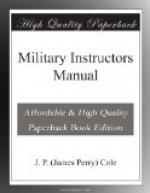explanation of situation and of individual duties
("repeats").
5. Rules for estimating numerical strength of the moving body of
troops (cf., f.s.r., sec. 27).
6. Point as a “march outpost” (=?) when the column is halted.
Only then may the A.G. point make any lateral arrangement of
its members (cf. 3 above).
Second Problem: Advance Guard Connecting File, cf., f.s.r., reference above:
A. Definition and Function.—Two men (usually) for liaison en route where elements too widely separated or roads too curved and wooded. Distance 200 to 5 yards apart.
B. Principles:
1. Constant touch with elements
before and behind.
2. Relay both ways messages sent to or
from remoter parts of the
column. Speed and accuracy of signaling.
3. Guide to be forward in daytime, at night
on the main body.
Third Problem: Advance Guard Flank Patrol, pp. 31-32:
A. Definition and Function.—For protecting a marching column from attack, by warning it on the basis of information gained in reconnaissance. Interval between men depends on circumstances.
B. Principles:
1. Start from near head
of the column, i.e., from smallest
element in the advance guard that can afford
to cut down its
numbers.
2. Speed rather than safety, to keep abreast
of own column and
to force the enemy to disclose himself by
firing on F.P.
rather than on main body.
3. Sent to investigate suspicious areas,
e.g. in woods, behind
houses.
4. Action in case of firing on main body;
advance and
counterfire, deployed.
5. Get-away man in rear of column.
6. Stick to the job: no wandering
or chasing of enemy beyond
range of column. Job is to warn and
protect against flank
attack.
Fourth Problem: Platoon as Advance Party:
A. Definition and Function:
Body of infantry, amounting to
1/8 to 1/2 the Support
(depending on the number of cavalry ahead)
cf., f.s.r., p.
28.
Duty.—To back up the point and the
advance cavalry (if any) if
fired upon; remove enemy bodies and other
obstacles.
B. Principles:
1. Describe general mission
to inferiors.
2. Explain individual duties to inferiors.
3. Send out point and connecting files.
4. Form in platoon; zig-zag.
5. Keep going; prosecute engagements briskly,
not to delay main
column.
6. Procedure under fire: deploys and
drops, when fired upon;
looks for enemy’s direction and assigns
target and range.
Advance under cover if any, when fire light;
when heavy seek
to divert fire to you away from main body
of advance guard to
facilitate latter’s disposition for
advance to your support.
Seek to drive off a weaker enemy, and to
hold off a stronger.
7. Speedy decisions. Value of imaginary
situations, while on the
march; and planning your commands.




